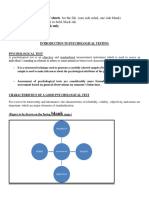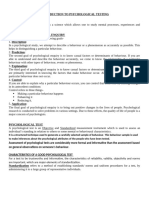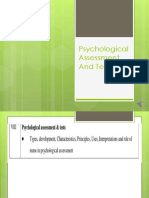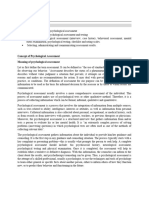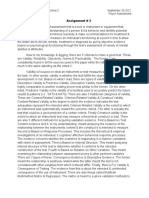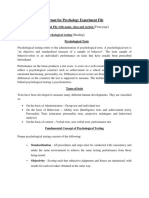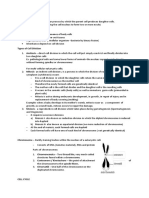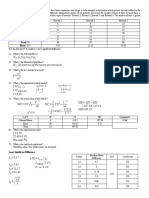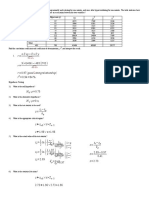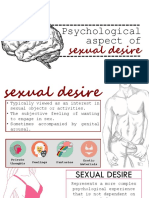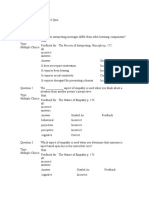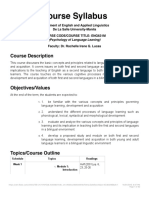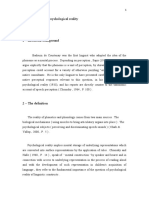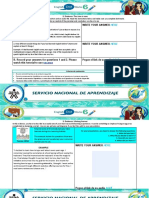From Cohen Swerdlik's Book of Psychological Testing and Assessment: An Introduction To Tests and Measurement 7th Edition
From Cohen Swerdlik's Book of Psychological Testing and Assessment: An Introduction To Tests and Measurement 7th Edition
Uploaded by
Summer LoveCopyright:
Available Formats
From Cohen Swerdlik's Book of Psychological Testing and Assessment: An Introduction To Tests and Measurement 7th Edition
From Cohen Swerdlik's Book of Psychological Testing and Assessment: An Introduction To Tests and Measurement 7th Edition
Uploaded by
Summer LoveOriginal Title
Copyright
Available Formats
Share this document
Did you find this document useful?
Is this content inappropriate?
Copyright:
Available Formats
From Cohen Swerdlik's Book of Psychological Testing and Assessment: An Introduction To Tests and Measurement 7th Edition
From Cohen Swerdlik's Book of Psychological Testing and Assessment: An Introduction To Tests and Measurement 7th Edition
Uploaded by
Summer LoveCopyright:
Available Formats
Differentiate psychological testing and psychological assessment
From Cohen Swerdlik’s book of Psychological Testing and Assessment: An Introduction to
Tests and Measurement 7th Edition: We define psychological assessment as the gathering and
integration of psychology - related data for the purpose of making a psychological evaluation
that is accomplished through the use of tools such as tests, interviews, case studies, behavioral
observation, and specially designed apparatuses and measurement procedures. We define
psychological testing as the process of measuring psychology-related variables by means of
devices or procedures designed to obtain a sample of behavior.
Psychological testing is a standard procedure of measurement designed to measure
characteristics, abilities, personality etc. Psychological tests are written, visual or verbal
evaluations administered to assess the cognitive and emotional functioning of children and
adults.
Psychological assessment is a process that involves the integration of information from multiple
sources, such as tests related to ability, intelligence, interests or attitudes as well as information
from personal interviews.
So it can be also said that psychological testing collects one aspects of information while
psychological assessment covers every aspects of collection of information.
The assessment process combines and evaluates all the information gathered about an
individual while test provides only a part of the picture about a person.
Testing and assessment have been important foundations of counseling and applied psychology.
Tests have important roles both as tools to facilitate the goals of counseling and for assessment.
Identify the psychological functions that may be subjected to psychological testing
(www.psychologyinfo.com/treatment/testing.html)
Psychological testing covers a number of different areas:
Mental health assessment - A mental health assessment includes information about a person’s
medical history, their family history, and the current status of their mental health. The
assessment helps identify if there are any mental health issues present, and determine a
diagnosis and treatment accordingly.
A psychologist or psychiatrist is likely to start an appointment with a mental health assessment,
which will enable them to correctly diagnose and treat you.
Adaptive behavior assessments - This measures the social and practical skills of a person, to
determine their ability to function on a daily basis at home, school or work; and are usually
conducted along with cognitive tests. For example, it may be used to assess a child’s ability to
function in social activities with other students in school.
Aptitude testing - An aptitude test measures a person’s ability to perform different kinds of
tasks. This is done to determine the areas in which their skills are the strongest. Some people
may be better with quantitative tasks that require math and logical reasoning skills, some at
language, and some at creative thinking.
These tests are used by vocational therapists to measure ability, and figure out the kind of
professions or job roles a person may be suited for. They may also be used by career counselors
to guide people towards higher education in fields where they demonstrate high ability.
Cognitive testing - A cognitive test measures a person’s cognitive abilities— problem solving,
reasoning, vocabulary, comprehension, and memory. They are more commonly known as
intelligence or IQ tests, and are used in the field of education to identify a person’s strengths
and potential.
For instance, a child may be given a cognitive test to measure their ability in different subjects;
allowing educators to help the child work on the subjects they’re having trouble with.
Educational/achievement testing - Educational testing is conducted to test how much an
individual has progressed in learning a specific subject—like mathematics, reading
comprehension—to identify any difficulties they may have had in it.
Achievement tests are the examinations that students take in schools and colleges.
Forensic psychological testing - Forensic testing is used in the legal field, to determine whether a
suspect is capable of committing the crime they have been accused of. It comprises cognitive,
personality, and neuropsychological tests.
Neuropsychological testing - Neuropsychological tests analyze how an individual’s brain works,
in order to identify any problems in its functioning. For instance, a person with a head injury
may have to undergo neuropsychological tests to check their brain’s ability to retain
information.
Personality assessment - A personality test focuses on the personality traits of an individual. It
helps evaluate if a person is more introverted or extroverted, cautious or spontaneous, and how
they may react or respond to various life situations.
Interpretation of psychological tests - Psychological tests are not meant to be interpreted
without the context of the person being tested—their environment, socioeconomic status or
physical health. While the tests do use scientifically verified scales, using its results as a stand-
alone criteria can lead to misinterpretation.
For example, in the case of a blood work report—it is necessary for a doctor to read the
numbers in relation to your symptoms and general physical health to arrive at an accurate
diagnosis.
Similarly, it’s important to note that even though many of the psychological tests mentioned
above are easily available on the internet, taking them without consulting a mental health
professional may not lead to getting an actual analysis of your personality, aptitude or behavior.
This in turn, could mean not getting the help you need.
Discuss the factors influencing the soundness of testing (reliability, standardization, validity,
practicality or utility)
Cohen Swerdlik’s book of Psychological Testing and Assessment: An Introduction to Tests and
Measurement 7th Edition: In the language of psychometrics, reliability refers to consistency in
measurement. And whereas in everyday conversation reliability always connotes something
positive, in the psychometric sense it really only refers to something that is consistent—not
necessarily consistently good or bad, but simply consistent.
Reliability is the extent to which a questionnaire, test, observation or any measurement
procedure produces the same results over a period of time.
Types of Reliability Estimates
Test-retest reliability indicates the repeatability of test scores with the
passage of time. This estimate also reflects the stability of the characteristic
or construct being measured by the test.
Some constructs are more stable than others. For example, an individual's
reading ability is more stable over a particular period of time than that
individual's anxiety level. Therefore, you would expect a higher test-retest
reliability coefficient on a reading test than you would on a test that measures
anxiety. For constructs that are expected to vary over time, an acceptable
test-retest reliability coefficient may be lower than is suggested in Table 1.
Alternate or parallel form reliability indicates how consistent test scores
are likely to be if a person takes two or more forms of a test.
A high parallel form reliability coefficient indicates that the different forms of
the test are very similar which means that it makes virtually no difference
which version of the test a person takes. On the other hand, a low parallel
form reliability coefficient suggests that the different forms are
probably not comparable; they may be measuring different things and
therefore cannot be used interchangeably.
Inter-rater reliability indicates how consistent test scores are likely to be if
the test is scored by two or more raters.
On some tests, raters evaluate responses to questions and determine the
score. Differences in judgments among raters are likely to produce variations
in test scores. A high inter-rater reliability coefficient indicates that the
judgment process is stable and the resulting scores are reliable.
Inter-rater reliability coefficients are typically lower than other types of
reliability estimates. However, it is possible to obtain higher levels of inter-
rater reliabilities if raters are appropriately trained.
Internal consistency reliability indicates the extent to which items on a
test measure the same thing.
A high internal consistency reliability coefficient for a test indicates that the
items on the test are very similar to each other in content (homogeneous). It
is important to note that the length of a test can affect internal consistency
reliability. For example, a very lengthy test can spuriously inflate the
reliability coefficient.
Tests that measure multiple characteristics are usually divided into distinct
components. Manuals for such tests typically report a separate internal
consistency reliability coefficient for each component in addition to one for the
whole test.
Test manuals and reviews report several kinds of internal consistency
reliability estimates. Each type of estimate is appropriate under certain
circumstances. The test manual should explain why a particular estimate is
reported.
Standardization establishes a set precedence, therefore enhancing an assignment, test or
projects’ reliability. The use of uniform procedures in the administration of tests to ensure that
all participants are scoring the same results under the same conditions. It is important that the
tests are administered and scored according to the same rules and procedures.
In essence, this type of standardization tries to reduce the influence of any extraneous variable
on the test or experimental performance of participants. If procedures are not standardized,
this will affect reliability and internal validity and result in biased findings.
Cohen Swerdlik’s book of Psychological Testing and Assessment: An Introduction to Tests and
Measurement 7th Edition: In the language of psychological assessment, validity is a term used
in conjunction with the meaningfulness of a test score—what the test score truly means.
Validity is defined as, the extent to which the instrument measures what it sets out to measure.
Teachers must identify the expected learning outcomes and goals of the course in order to
appropriately assess student work.
Practicality refers to the action of the assessment method and its relevance to the overall
learning goals in the course. It also addresses whether or not the workload for the instructor is
reasonable. Practicality in assessment means that the test is easy to design, easy to administer
and easy to score. No matter how valid or reliable a test is, it has to be practical to make and to
take this means that: It is economical to deliver. It is not excessively expensive
Familiarize and describe the standardized procedures in test administration
(https://images.pearsonassessments.com/images/tmrs/tmrs_rg/AdministrationPractices.pdf)
From what I learned in Zucker et al’s Administration Practices for Standardized Assessments:
The goal of this uniformity is to make the assessment’s results as objective as possible so that
they can be considered valid and meaningful when used to compare the assessed qualities of
students.
The use of orderly, standardized test administration procedures is beneficial to examinees. In
particular, administration procedures designed to promote consistent conditions for all
examinees increase the exam program's fairness. Test administration procedures related to
security protect the integrity of the test items. In both of these cases, the standardization of test
administration procedures prevents some examinees from being unfairly advantaged over other
examinees.
The directions for administering for each assessment product provide specific instructions for
procedures to follow before, during, and after test administration. The examinees are each
developed and evaluated prior to test standardization. During standardization, the materials are
verified for accuracy and utility.
You might also like
- Characteristics of A Good Psycological TestDocument7 pagesCharacteristics of A Good Psycological Testapi-24997084082% (11)
- Dietetics Study Data Between Calcium Intake and Knowledge About CalciumDocument5 pagesDietetics Study Data Between Calcium Intake and Knowledge About CalciumSummer LoveNo ratings yet
- Entrance Exam TEFLDocument5 pagesEntrance Exam TEFLSandro JonesNo ratings yet
- Differentiation StrategiesDocument3 pagesDifferentiation Strategiesapi-280270993100% (1)
- Stress, Memory, and The Hippocampus: Can't Live With It, Can't Live Without ItDocument22 pagesStress, Memory, and The Hippocampus: Can't Live With It, Can't Live Without ItsoylahijadeunvampiroNo ratings yet
- ESSAYDocument6 pagesESSAYRonald James Albeza FielNo ratings yet
- Practical Viva Voce First YearDocument5 pagesPractical Viva Voce First YearmrigankNo ratings yet
- PPM (Achievement Test)Document82 pagesPPM (Achievement Test)Aisha NoorNo ratings yet
- Psych Testing IssuesDocument13 pagesPsych Testing IssuesJohn Russell MoralesNo ratings yet
- Psychological Testing IntroductionDocument13 pagesPsychological Testing IntroductionziapsychoologyNo ratings yet
- ValidityDocument4 pagesValiditychayanika sharmaNo ratings yet
- What To Look For in A Psychological TestDocument32 pagesWhat To Look For in A Psychological TestKella OrtegaNo ratings yet
- Psychological AssessmentDocument27 pagesPsychological AssessmentSukumar ManiNo ratings yet
- Psychometric Assessmenti PrintoutDocument33 pagesPsychometric Assessmenti PrintoutsugaNo ratings yet
- Applications of Psychological Test in Education and CounsellingDocument22 pagesApplications of Psychological Test in Education and CounsellingShweta Poonam100% (1)
- Advanced Psychology Testing and Test Constuctions Psy 461Document23 pagesAdvanced Psychology Testing and Test Constuctions Psy 461AdelinaNo ratings yet
- Psychometric AssessmentDocument19 pagesPsychometric Assessmentkiran mahal80% (5)
- Types of Psychological Test: 1. Achievement and Aptitude TestsDocument6 pagesTypes of Psychological Test: 1. Achievement and Aptitude TestsSanya DalmiaNo ratings yet
- Introduction To Psychological TestingDocument5 pagesIntroduction To Psychological Testingmohiniuppal27No ratings yet
- Definition and Nature of Psychological TestDocument4 pagesDefinition and Nature of Psychological TestHafiz Musehif KhokharNo ratings yet
- Introduction To Psychometric Testing FINALDocument7 pagesIntroduction To Psychometric Testing FINALtripathi2007soumyaNo ratings yet
- NColge 1373 Assessment in Counselling&GuidanceDocument5 pagesNColge 1373 Assessment in Counselling&GuidanceNaveenNo ratings yet
- Introduction To Psychological Testing-1Document5 pagesIntroduction To Psychological Testing-1Rudra YadavNo ratings yet
- Introduction To Psychological TestingDocument5 pagesIntroduction To Psychological TestingKhushi GandhiNo ratings yet
- Introduction To Psychological TestingDocument18 pagesIntroduction To Psychological Testingkhush100% (3)
- General Introduction To Psychological AssessmentDocument5 pagesGeneral Introduction To Psychological AssessmentAvantika PvNo ratings yet
- General Intro Fromm AlbertDocument6 pagesGeneral Intro Fromm Albertycq5s9jdgnNo ratings yet
- Norms (Topic 15)Document5 pagesNorms (Topic 15)sarahfatimakhan04No ratings yet
- Name: Reg NO: Course Code: 6507 SEMESTER: Spring 2022Document21 pagesName: Reg NO: Course Code: 6507 SEMESTER: Spring 2022salma salmaNo ratings yet
- Assessment in Clinical PsychologyDocument5 pagesAssessment in Clinical PsychologyWardah IshfaqNo ratings yet
- Psychological Test: Assignment On Guidance and CounsellingDocument6 pagesPsychological Test: Assignment On Guidance and CounsellingAntoNo ratings yet
- Psychological Assessment and TestDocument25 pagesPsychological Assessment and TestMobin AlamNo ratings yet
- Diff Between Psychological Assessment and TestingDocument6 pagesDiff Between Psychological Assessment and TestingAkshita Singh100% (2)
- Psychological Testing HR PerspectiveDocument6 pagesPsychological Testing HR PerspectiveSauvik SarkhelNo ratings yet
- Chapter 1 - Updated Introduction To Psychological TestingDocument28 pagesChapter 1 - Updated Introduction To Psychological TestingReshmonica Athi Rao100% (3)
- Psychometric Properties IndividualsDocument4 pagesPsychometric Properties IndividualsSantosh Atfb100% (1)
- Psychological TestingDocument7 pagesPsychological TestingjoyesmonpulickalNo ratings yet
- Unit 7Document16 pagesUnit 7Ananta ChaliseNo ratings yet
- Psychological AssessmentDocument5 pagesPsychological AssessmentHeidi BrionesNo ratings yet
- To Psychological TestingDocument18 pagesTo Psychological TestingEla Nangai0% (1)
- II - Nature and Uses of Psychological TestDocument7 pagesII - Nature and Uses of Psychological TestJPA Printing ServicesNo ratings yet
- Application of Psychological Tests in Education CounsellingDocument22 pagesApplication of Psychological Tests in Education CounsellingShweta PoonamNo ratings yet
- Written Exam-Guleng, Adrian AngelicoDocument21 pagesWritten Exam-Guleng, Adrian AngelicoAdrian Esico GulengNo ratings yet
- History of Psychological TestDocument5 pagesHistory of Psychological TestKyle BadidlesNo ratings yet
- We Have Solved Guess Papers, 5 Years Papers & Notes For Students. For More Information Contact 0331-7602942 Pak PhotostatDocument17 pagesWe Have Solved Guess Papers, 5 Years Papers & Notes For Students. For More Information Contact 0331-7602942 Pak PhotostatCarry OnNo ratings yet
- Dr. Most. Aeysha Sultana (MAS1) : PSY 101L: Psychological Experiment and TestingDocument13 pagesDr. Most. Aeysha Sultana (MAS1) : PSY 101L: Psychological Experiment and TestingAsrafia Mim 1813026630No ratings yet
- Psychological Assement Lab Week 2 2Document54 pagesPsychological Assement Lab Week 2 2Yhana Ruth PajitaNo ratings yet
- Testing and AssessmentDocument14 pagesTesting and AssessmentanikaafreenansariNo ratings yet
- Measuring PersonalityDocument24 pagesMeasuring PersonalityAyesha AyubNo ratings yet
- Self EsteemDocument35 pagesSelf EsteemRachana YadavNo ratings yet
- Introduction To Clinical AssessmentDocument7 pagesIntroduction To Clinical AssessmentJahnaviNo ratings yet
- Assignment 2 - Psych AssessmentDocument3 pagesAssignment 2 - Psych AssessmentChunelle Maria Victoria EspanolNo ratings yet
- InesSinthyaBrPandia - Reliability and Validity (Repitition, Review)Document3 pagesInesSinthyaBrPandia - Reliability and Validity (Repitition, Review)Ines Sinthya PandiaNo ratings yet
- Education Psychology and MeasurementtechniquesDocument41 pagesEducation Psychology and Measurementtechniqueszoyaaak201No ratings yet
- Kepy - 01 - 06 - 24 - EtextDocument10 pagesKepy - 01 - 06 - 24 - Etextmradul guptaNo ratings yet
- Psychology Practical FileDocument5 pagesPsychology Practical FileswdefrgbhnjmNo ratings yet
- Psychological TestDocument5 pagesPsychological TestRidhimaa DevlalNo ratings yet
- Assignment TestingDocument21 pagesAssignment Testinghina FatimaNo ratings yet
- Rotter Prac PaDocument18 pagesRotter Prac PaAnu SharmaNo ratings yet
- 3.4. Validity, Reliability and FairnessDocument3 pages3.4. Validity, Reliability and Fairnesssaharafzal190No ratings yet
- Practical Guide to Child and Adolescent Psychological TestingFrom EverandPractical Guide to Child and Adolescent Psychological TestingNo ratings yet
- C. B. Macpherson's Political TheoryDocument18 pagesC. B. Macpherson's Political TheorySummer LoveNo ratings yet
- To Define Clinical Psychology, Here Is A Definition From American Psychological Association's Division 12Document14 pagesTo Define Clinical Psychology, Here Is A Definition From American Psychological Association's Division 12Summer LoveNo ratings yet
- Induced Abortion and STDDocument15 pagesInduced Abortion and STDSummer LoveNo ratings yet
- Sack RaceDocument1 pageSack RaceSummer LoveNo ratings yet
- Meiosis and MitosisDocument6 pagesMeiosis and MitosisSummer LoveNo ratings yet
- H Μ Μ Μ H S S F>F F>F F >3.10 V K (N−1) V V K−1 V Sse=Sst −Ssc Sse=84.33 Ssc= N Σti T.. Nk Sst =Σσ X T.. NkDocument2 pagesH Μ Μ Μ H S S F>F F>F F >3.10 V K (N−1) V V K−1 V Sse=Sst −Ssc Sse=84.33 Ssc= N Σti T.. Nk Sst =Σσ X T.. NkSummer LoveNo ratings yet
- The Plague (1947) Is The Chronicle of A Cruel Epidemic That Allegedly Struck Oran, A Small Town in AlgeriaDocument1 pageThe Plague (1947) Is The Chronicle of A Cruel Epidemic That Allegedly Struck Oran, A Small Town in AlgeriaSummer LoveNo ratings yet
- Global CitizenshipDocument37 pagesGlobal CitizenshipSummer LoveNo ratings yet
- Psych Stat 2Document2 pagesPsych Stat 2Summer LoveNo ratings yet
- Psych Stat Problem and AnswersDocument3 pagesPsych Stat Problem and AnswersSummer LoveNo ratings yet
- AErobic ExerciseDocument11 pagesAErobic ExerciseSummer LoveNo ratings yet
- "Bayan o Sarili?": Reflection: Heneral LunaDocument3 pages"Bayan o Sarili?": Reflection: Heneral LunaSummer LoveNo ratings yet
- ITMM - Non PolyhedraDocument3 pagesITMM - Non PolyhedraSummer LoveNo ratings yet
- Module 15 NSTPDocument21 pagesModule 15 NSTPSummer LoveNo ratings yet
- Social IssuesDocument4 pagesSocial IssuesSummer LoveNo ratings yet
- Narrative Report in Earthscience: Third Grading PeriodDocument3 pagesNarrative Report in Earthscience: Third Grading PeriodSummer LoveNo ratings yet
- Psych Aspect of Sexual DesireDocument8 pagesPsych Aspect of Sexual DesireSummer LoveNo ratings yet
- Video Games Presentation.Document10 pagesVideo Games Presentation.Bouthaina Al AbrashNo ratings yet
- Creative Problem Solving: Optimist International 1Document51 pagesCreative Problem Solving: Optimist International 1Anonymous 0HycR53100% (1)
- 9 Types of IntelligenceDocument6 pages9 Types of IntelligenceAnonymous DpycJHANo ratings yet
- Place Value and Patterns: Are You Ready?Document6 pagesPlace Value and Patterns: Are You Ready?evaNo ratings yet
- Speech and Oral Communication Module (Front Page)Document4 pagesSpeech and Oral Communication Module (Front Page)Deah Dee100% (1)
- Chapter 06 QuizDocument10 pagesChapter 06 QuizPRAJWAL BHANGENo ratings yet
- Cohen, & Hicks. Prospective Memory. 2017Document111 pagesCohen, & Hicks. Prospective Memory. 2017Dafny C. AroneNo ratings yet
- Tutorial - Week 6 - MCQDocument4 pagesTutorial - Week 6 - MCQDesheng ChewNo ratings yet
- Music Lesson PlanDocument2 pagesMusic Lesson Planapi-384625467No ratings yet
- 8 Intelligences Description SheetDocument2 pages8 Intelligences Description SheetSilence checkmateNo ratings yet
- Habit 2 Part 2 From The 7 Habits LargeDocument78 pagesHabit 2 Part 2 From The 7 Habits Largeabdul rehman100% (1)
- Animals Grow Hessa Science: Students Will Need To Be Familiar With The Vocabulary WordsDocument4 pagesAnimals Grow Hessa Science: Students Will Need To Be Familiar With The Vocabulary WordsHessa MohammedNo ratings yet
- Primeira InfânciaDocument21 pagesPrimeira InfânciaCarlos LemesNo ratings yet
- PLL Modules ReviewerDocument92 pagesPLL Modules ReviewerNguyen HalohaloNo ratings yet
- The Giving TreeDocument3 pagesThe Giving TreeAnonymous CclZouNo ratings yet
- Biology of MemoryDocument43 pagesBiology of MemoryyayayanizaNo ratings yet
- The Oral Approach and Situational Language TeachingDocument16 pagesThe Oral Approach and Situational Language TeachingSonia RafiqueNo ratings yet
- Overcoming The Ebbinghaus Forgetting Curve With Virtual RealityDocument5 pagesOvercoming The Ebbinghaus Forgetting Curve With Virtual RealityNikko EchanezNo ratings yet
- Critical Period Hypothesis EssayDocument3 pagesCritical Period Hypothesis EssayslezhummerNo ratings yet
- Music Education Lesson Plan Template: Oregon State UniversityDocument5 pagesMusic Education Lesson Plan Template: Oregon State Universityapi-358158350No ratings yet
- PhysioDocument2 pagesPhysioRaeann Fiona FranciscoNo ratings yet
- Sequencing Lesson PlanDocument2 pagesSequencing Lesson Planapi-298314457No ratings yet
- The Phoneme As A Psychological RealityDocument6 pagesThe Phoneme As A Psychological Realityanmar ahmed100% (1)
- Fuente: SENA Write Your Answer: 2. Evidence: The Time Is NowDocument3 pagesFuente: SENA Write Your Answer: 2. Evidence: The Time Is NowJhon RuizNo ratings yet
- Marzano's 6 Steps For Teaching VocabularyDocument2 pagesMarzano's 6 Steps For Teaching VocabularykoglerjhNo ratings yet
- RRL EditDocument6 pagesRRL EditAnalea C. AñonuevoNo ratings yet
- Lesson Plan 4Document4 pagesLesson Plan 4api-454030864No ratings yet



















